What Type of Content is Best for SEO?
In 2022, the sheer power of content cannot be ignored anymore.
Web users are hungry for engaging, value-added, and relevant content that answers their questions to a tee.
Let’s say you want to install a new iron door in your home. Before you kick things off, you’ll run a quick Google search for the best iron door features, the benefits of installing iron doors, the top iron door companies in your area, and so on.
What will Google fetch? Content.
As you read a few blogs and articles, scan an infographic or two, and watch a couple of videos, you’ll be ready to take the leap. Millions of consumers follow the same process. Content is everywhere because it’s consumed in abundance.
When you make smart, calculated content decisions, you can easily steer your company in the right direction.
In this blog, we’ll cover the nitty-gritty of clever content selection.
- What are different kinds of SEO content?
- What type of content is best for SEO?
- What are some of the best SEO content examples that you should recreate?
Buckle up; our SEO experts are breaking everything down!
What Are Different Kinds of SEO Content?
There are many, many different kinds of SEO content. We doubt you’ll find a brand that covers all of them. The goal isn’t to become a jack of all trades. Instead, you have to master the art of picking the most effective types of content for your brand, audience, industry, and goals.
Your content goals should always be SMART (specific, measurable, actionable, relevant, and time-bound).
We get it. You may feel tempted to launch a comprehensive strategy that covers everything. While this sounds like a great approach on paper, it backfires in practice.
Start off slow. Create a specific, relevant, achievable campaign. Use this guide:
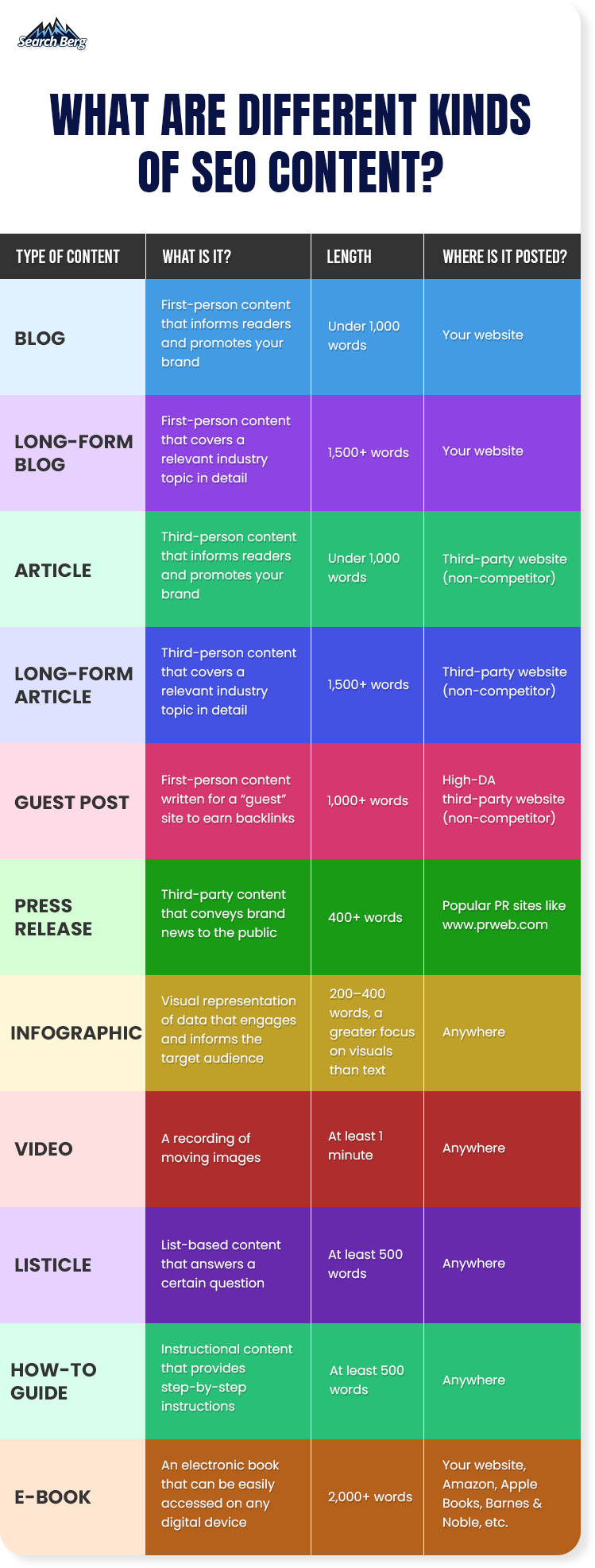
At Search Berg, we shortlist the right types of content for your business. This cannot be done casually and hastily. We perform a content audit to understand your performance and shape your goals. This is combined with in-depth knowledge about your audience and industry. Of course, we keep the demand for each type of content in mind as well.
The outcome is a robust, relevant, and powerful SEO content campaign that helps you hit the ground running!
If you’re unsure about which content is right for you, call our team today. In the meantime, we’ll highlight the most effective, high-demand, and powerful content that can help you achieve your goals.
Let’s get right to it!
The Most Effective Types of SEO Content
1. Blogs
92% of content marketers post consistent blogs. Why? Because blogs are the undefeatable king of content.
If you’re just starting off with SEO content writing, your first campaign should include blogs, no questions asked. A well-researched, well-written, value-added, and optimized blog can help you rank higher on Google SERPs, transform your traffic reports, and reel in a high volume of conversions.
Sounds like a dream, right?
Blog writing is untouchable in the content den. If you get it right, you’re sitting on the precipice of tremendous brand growth and success.
The best part? There’s ample room for experimentation.
Your blog should be at least 400 words long. This is a regular/short-form blog. Anything above 1,500 words qualifies as a long-form blog.
Keep these key differences in mind:
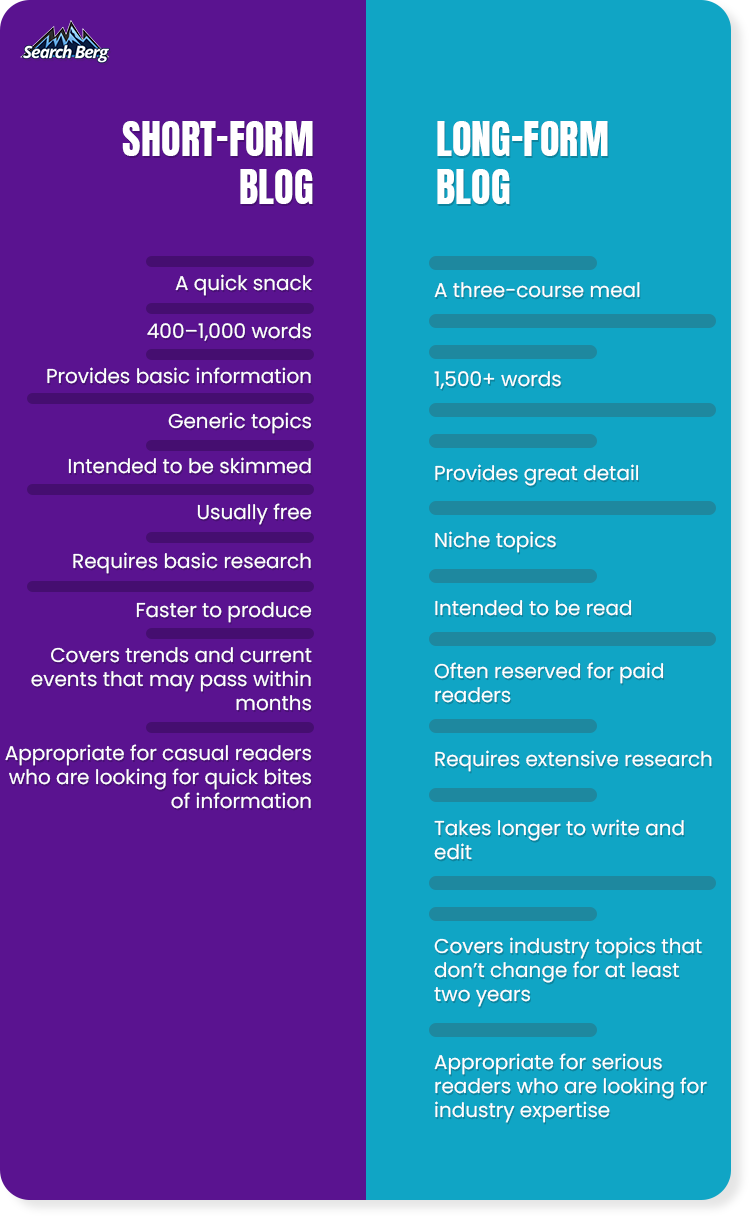
If you’re just starting off with content writing, opt for short-form blogs. Once you learn the ropes, you can branch out into the long-form blogging territory. Long-form blogs must be written by experienced writers with industry expertise.
Once you switch from short-form to long-form blog writing, you’re expected to provide a nuanced commentary on complex topics. This is not for the faint-hearted. If you lack specialized industry knowledge, your blog will fall flat on its face.
Take some time to find writers who can meet your target audience’s high long-form blogging expectations. In the meantime, launch engaging, exciting, and value-added short-form blogs that inform and resonate with your audience.
Your blog should immediately hook readers, gradually break down the topic in an understandable and readable manner, maintain an engaging and active tone, and seal the deal with a smart call-to-action (CTA).
Here’s a great example:
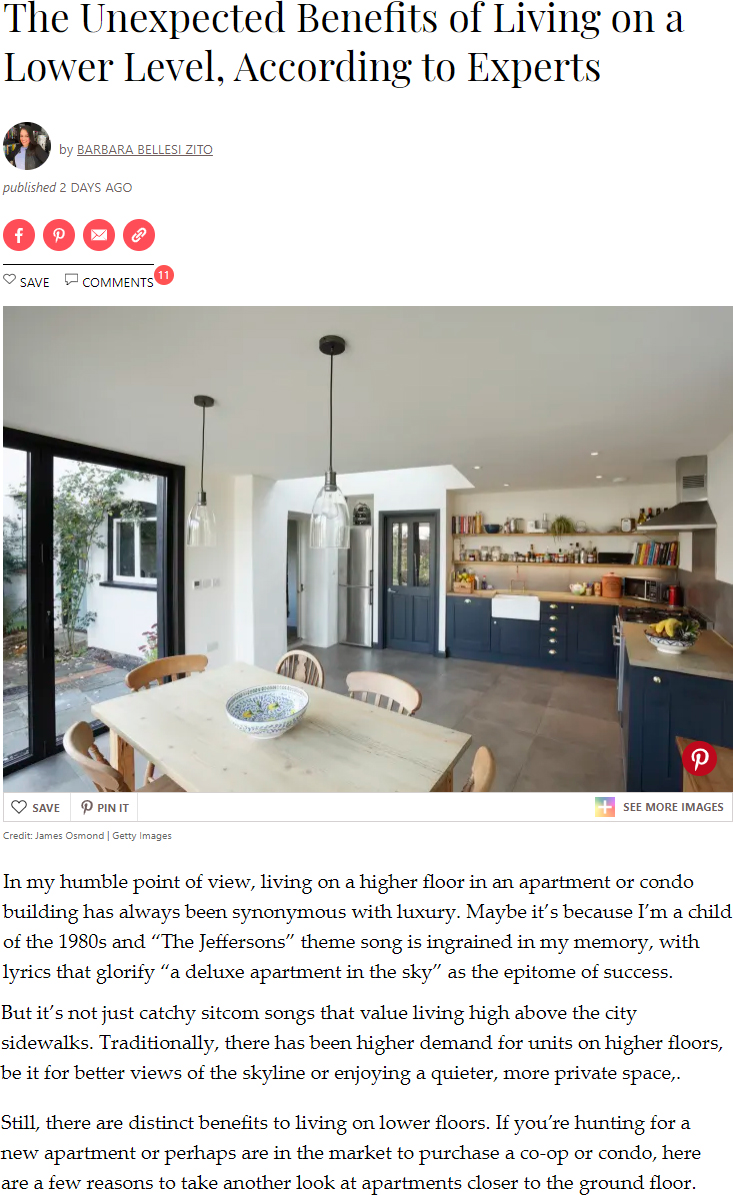
Titled The Unexpected Benefits of Living on a Lower Level, According to Experts, this blog by Apartment Therapy is quite the treat.
From the click-worthy title to the eye-catching image to the witty, exciting introduction, every blog component has been mastered like a pro.
This blog isn’t boring; it’s fast-paced, fun, and action-packed. The writer paints such a breathtaking picture that we’re not even bothered by the ads. This is how you do it!
3 HIIT Workouts for Beginners: Start Interval Training and Sprint Running is another excellent example by Nerd Fitness.
As you start reading the blog, its clever introduction will hook you from the get-go. Our favorite part, however, has to be the string of actionable CTAs. Since this is a long-form blog, it includes several CTAs that have been seamlessly woven into the content. The ratio is just right.
Here are the two distinct CTAs:
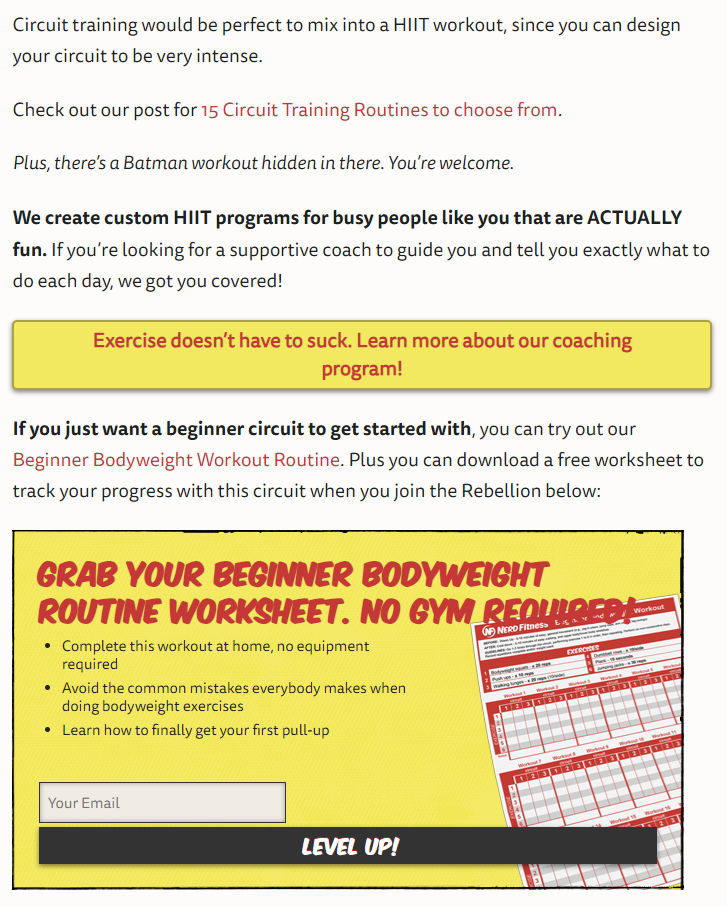
And another one:
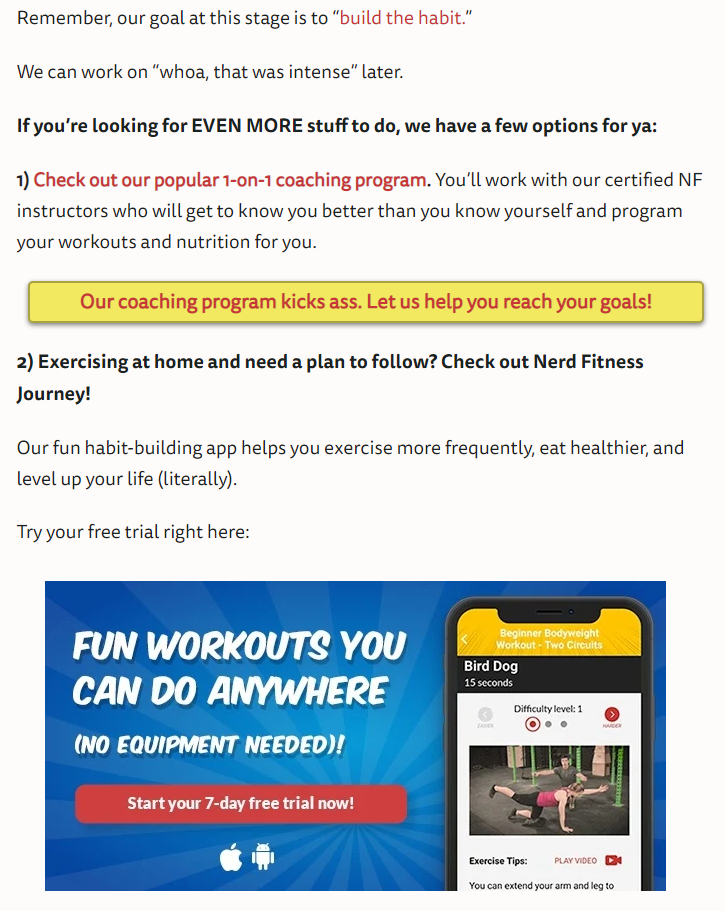
Supplemented with pictures, the CTAs have visual appeal. This increases their click potential.
Of course, we can’t ignore the fun quips that breathe life into something as transactional as a CTA. Explore more SEO content examples to master the art of blog writing.
Once you get the hang of this, you can win your audience over with content!
Recommended Read: How to Write a Blog That Ranks
2. Listicles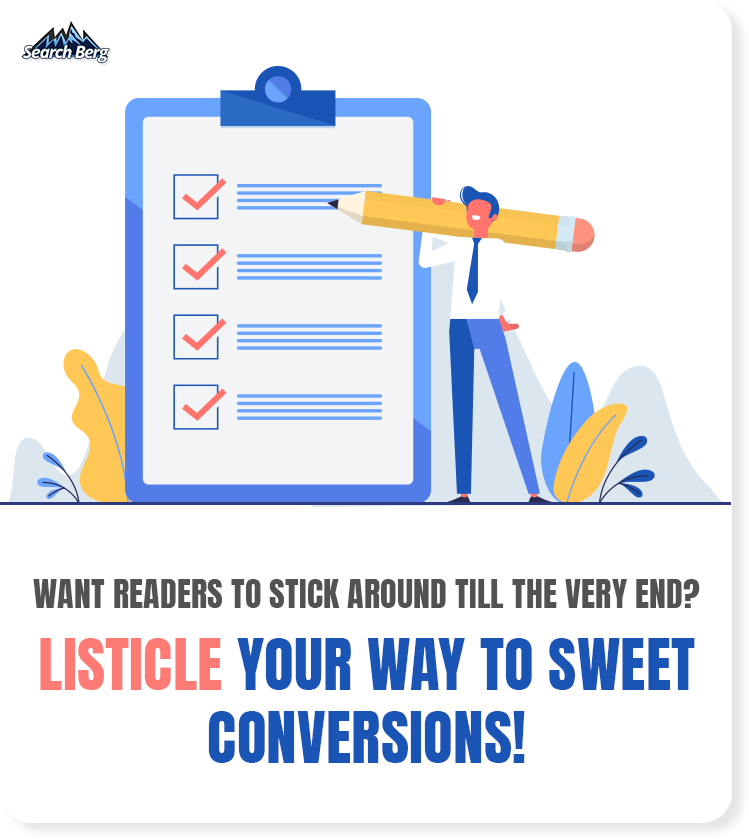
In 2022, everyone’s talking about listicles. A listicle, quite simply, is a hybrid of a list and an article. Think of it as an article in list form.
Let’s understand why it’s so popular. As humans, we’re hard-wired to enjoy list-based content. The Guardian’s brilliant article titled The Psychology of the To-Do List—Why Your Brain Loves Ordered Tasks breaks down the popularity of lists.
They give us much-needed structure and a plan that we can follow. They also reduce the stress, anxiety, and chaos around chores. The New Yorker further elaborates on this in A List of Reasons Why Our Brains Love Lists.
When dense information is broken down into small, bite-sized chunks of content, it’s easier to digest. We make and read lists because they’re simpler, easier, and quicker to scan than bulky paragraphs. Apply the same logic to your audience!
As our lives become increasingly fast-paced, time is the most valuable asset for everyone. As a marketer, your job is to give your audience what it wants in the least amount of time possible.
Content of choice based on this logic? Listicles. Powerful, effective, and read all the way through for a change, listicles are your golden ticket to entering conversion land.
Select an instructional topic that can be addressed with list-based content.
Listicles always start with a number.
Here are some examples:
- 6 Hassle-Free Ways to Clean Your Swimming Pool
- 5 Steps to Booking a Cheap Flight Online
- 7 Secrets to Achieving Perfect Work-Life Balance According to Top Managers
Get the gist? Your listicle shouldn’t be bulky. If you have too much content, break it down into a longer list (instead of 7 points, opt for 10). This will help you keep readability intact.
The goal is to inform your audience while accommodating a short attention span. Don’t take too long. Offer short, clean, crisp content that does its job fast!
As your audience sticks around till the very end, they’re more likely to convert. This is precisely what makes a listicle so powerful: its undefeatable conversion potential!
Want to learn how to write a power-packed listicle? WikiHow should be your guru.
The originator of listicles, WikiHow is known for its well-structured listicles.
Here’s a stellar example:
In 2022, everyone’s talking about listicles. A listicle, quite simply, is a hybrid of a list and an article. Think of it as an article in list form.
Let’s understand why it’s so popular. As humans, we’re hard-wired to enjoy list-based content. The Guardian’s brilliant article titled The Psychology of the To-Do List—Why Your Brain Loves Ordered Tasks breaks down the popularity of lists.
They give us much-needed structure and a plan that we can follow. They also reduce the stress, anxiety, and chaos around chores. The New Yorker further elaborates on this in A List of Reasons Why Our Brains Love Lists.
When dense information is broken down into small, bite-sized chunks of content, it’s easier to digest. We make and read lists because they’re simpler, easier, and quicker to scan than bulky paragraphs. Apply the same logic to your audience!
As our lives become increasingly fast-paced, time is the most valuable asset for everyone. As a marketer, your job is to give your audience what it wants in the least amount of time possible.
Content of choice based on this logic? Listicles. Powerful, effective, and read all the way through for a change, listicles are your golden ticket to entering conversion land.
Select an instructional topic that can be addressed with list-based content.
Listicles always start with a number.
Here are some examples:
- 6 Hassle-Free Ways to Clean Your Swimming Pool
- 5 Steps to Booking a Cheap Flight Online
- 7 Secrets to Achieving Perfect Work-Life Balance According to Top Managers
Get the gist? Your listicle shouldn’t be bulky. If you have too much content, break it down into a longer list (instead of 7 points, opt for 10). This will help you keep readability intact.
The goal is to inform your audience while accommodating a short attention span. Don’t take too long. Offer short, clean, crisp content that does its job fast!
As your audience sticks around till the very end, they’re more likely to convert. This is precisely what makes a listicle so powerful: its undefeatable conversion potential!
Want to learn how to write a power-packed listicle? WikiHow should be your guru.
The originator of listicles, WikiHow is known for its well-structured listicles.
Here’s a stellar example:
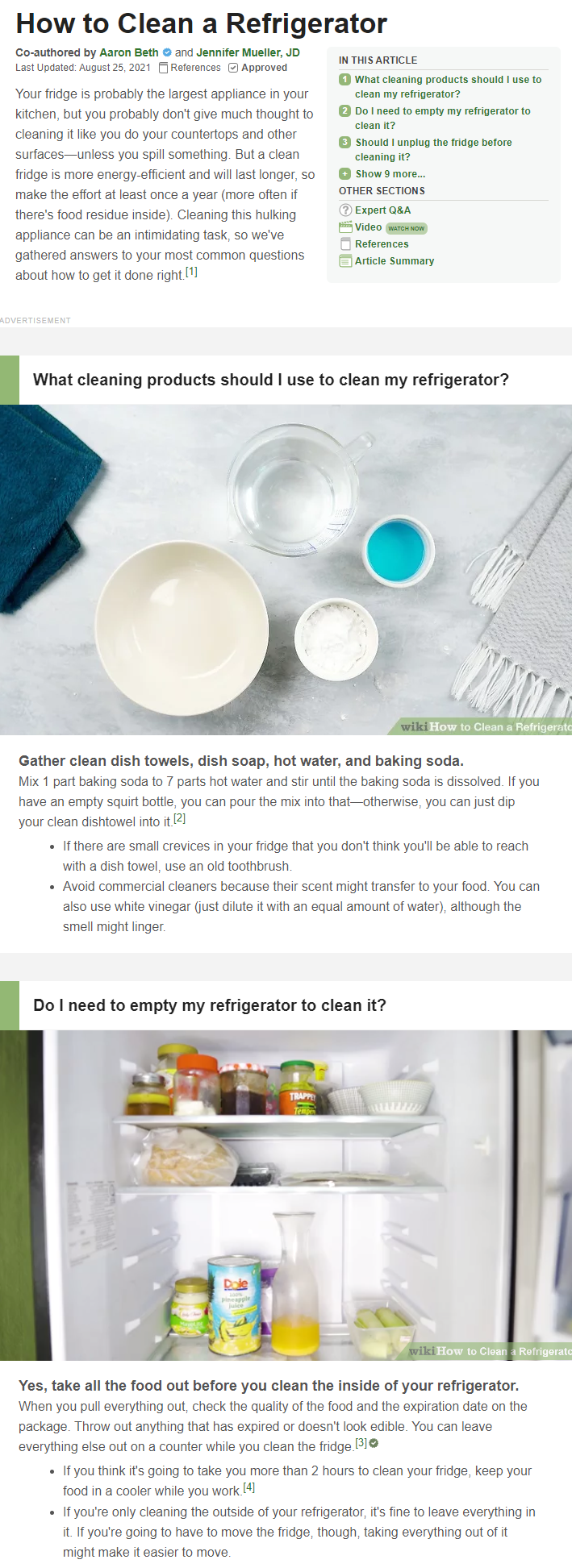
As you keep reading, you’ll notice that this is a pretty long listicle, yet its readability hasn’t been affected one bit. Why?
For starters, there are 12 main points, not 5 or 6. Each point includes subheadings and bullet points that break up the content as much as possible.
The best part? Every point has been supplemented with high-quality images and looped videos that provide visual relief.
You’re not overwhelmed with endless text. Instead, you get lots of visual breaks that increase the overall engagement of the content.
WikiHow listicles are a masterclass in flawless listicle writing. Once you get the hang of this type of content, you’re in for tremendous sales!
3. Long-Form Content

7,000+ words long-form content fetches 4x more traffic than its shorter counterparts. If you want your content to make a big splash, go long!
Whether you opt for an article or a blog, demonstrate industry expertise.
Your content should be immaculately researched, structured, and written. It’s easy to mess up long-form content.
Since you’re presenting a lot of information, you can easily fall into the pitfall of producing boring, banal, rehashed, and bulky content.
Avoid this by breaking your content up into as many segments as possible. Treat it like a listicle; you need to steer clear of bulk!
When done right, long-form content covers a niche industry topic in great detail. It equips readers with an A–Z understanding of the topic without boring them.
This is a tall order (pun intended, of course). How do you write so much content without putting your audience to sleep? For starters, maintain an active, engaging voice throughout your content.
Italicize, embolden, and underline relevant portions of the text to keep readers alert.
Add some personality to your content by using exclamation points and ellipses. Use relevant internal and external links to create a content map that readers can follow. The goal is to stimulate your readers as much as possible to earn those golden conversions.
As we stated earlier, long-form content should have multiple CTAs. As a rule of thumb, opt for 1 CTA per 800 words. You need to be smart about this. If you’re working on a dense or sensitive topic, don’t insert a CTA out of nowhere. The CTA should always be woven seamlessly into the content; it should be imperceptible.
If you cannot achieve this because of the nature of the content, hold off until you reach a point where a CTA can be appropriately inserted. As you improvise, you’ll retain readers like a seasoned pro. You don’t have to go by the book every time. Oftentimes, you’ll have to set the rulebook aside and create your own rules based on the unique circumstances.
Podcasting for Beginners: The Complete Guide to Getting Started With Podcasts is a masterclass in clever long-form blogging.
Buffer covers the nitty-gritty of starting a podcast without breaking a sweat!
Here’s one of our favorite portions from the blog:
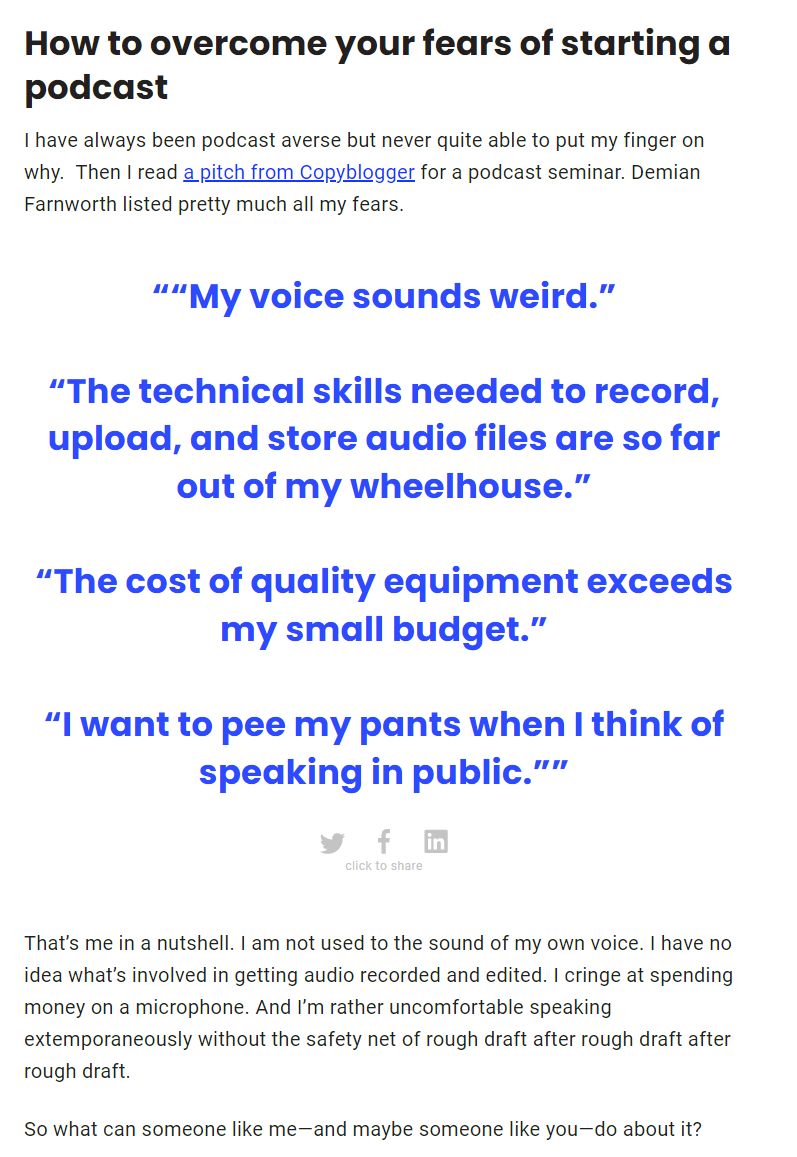
Short sentences, engaging tone, relatable scenario, and a brilliant segue. As you keep reading, you’ll notice that Buffer has further played up the texture and visual appeal of the blog by alternating between black and blue font colors.
There’s a beautiful balance here. It’s not overdone, nor are the colors too garish. It’s a subtle change that makes the blog so much more exciting!
As you work on long-form content, master the art of keeping things short yet comprehensive. You’re writing a lot of content, so the piece will be comprehensive by default.
However, it’s your job to avoid bulk by using short sentences and small paragraphs. Once you get the hang of it, your traffic reports will start shaping up!
4. Infographics
Visual content is a game-changer, no qualms about it.
If you want to win your audience over, satiate their visual thirst with powerful, dynamic, and eye-catching infographics! Pictures, graphics, animations, and concept illustrations drastically increase the readability of content.
The more visual your content, the better. You’re in for more clicks, conversions, and shares!
Start by selecting a topic with high demand. Find a set of high-volume keywords that can help your infographic rank higher on Google SERPs.
Now, comprehensiveness is key. Many marketers make the mistake of solely focusing on visuals to the point that their infographics lack relevant information. A great infographic achieves a balance between text and visuals.
Take a page right out of Jobvite’s book.

Reference: https://www.jobvite.com/wp-content/uploads/2022/08/5-Areas-Consolidating-TATech-Infographic.pdf
Clean, modern, visually exciting, and laden with bite-sized chunks of information, Five Areas You Can Improve by Consolidating Your TA Tech is the ideal infographic.
The research is immaculate, the structure is second-to-none, the color palette is refreshing and balanced, the fonts are consistent, and the CTA is powerful.
This infographic doesn’t falter in any way.
If you want to reel in and retain a wider audience, hire professional infographic designers who have a knack for creating high-quality, value-added, optimized, and visually impactful infographics.
This type of content is too powerful to be overlooked.
As you make full use of it, you’ll give your brand the online visibility it deserves!
5. Videos
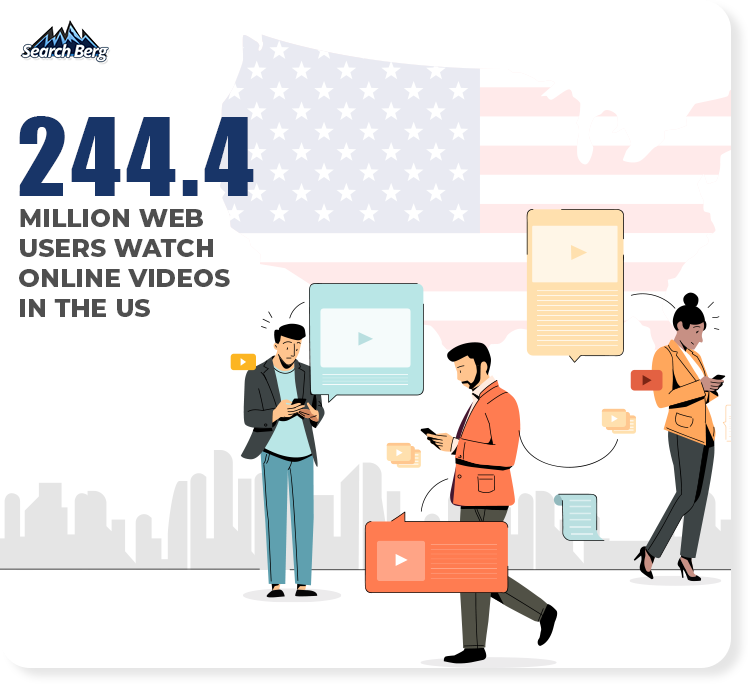
Video content is wildly popular, and we don’t see its popularity waning any time soon. If you want to get more eyes on your brand, video content should be your go-to.
Here’s the thing; People love visual content. It’s all about stimulating the senses.
When you switch from text to images, your eyes have a lot more to consume (colors, shapes, patterns, etc.). When you switch from images to video, you’re not just stimulating the eyes anymore. You’re also stimulating the ears through audio.
There’s a reason why 3D movies were all the rage back in the day. Today, 4D experiences have taken over.
As you start working on SEO content, quickly count how many senses it stimulates. The more, the better.
And no type of content appeals to people as much as video. There’s a ton of room for experimentation here!
You can create a wide, wide range of videos: explainer videos, product/service videos, testimonial videos, company culture videos, 360° experience videos, brand films, and so on.
The list is truly endless.
If you’re just getting started, opt for a powerful explainer video, i.e., a short marketing video that highlights a company’s products, services, business ideas, USPs, or just about anything else you want to make known.
Here are some of our favorite brand videos to inspire you:
- One Story Away by Netflix
- What Most Schools Don’t Teach by Code
- Make Home Count by IKEA
- Brotherly Love by Coca Cola
- Mamba Forever by Nike
- Best Toys Ever by Bark Box
- A Holiday Story, Featuring Maripol by Polaroid
6. Guest Posts

If you want to get seen by your target audience, you have to build quality backlinks.
And how do you do that? Through guest posting.
Touted as one of the smartest ways to build your brand through content, guest posting helps you connect with industry giants. The outcome? High rankings, impressive online visibility, a nice stream of traffic, and enviable conversions.
It’s like the domino effect. Tip the first card off, and the rest of your goals will also be checked off the list.
Okay, so what exactly are backlinks, and what on earth is a guest post?
A backlink is a hyperlink on a third-party website that takes web users to your website.
Let’s say you run an interior design business. You write a fantastic blog about minimalist interior design. As Architectural Digest works on their own piece on minimalism, they come across your blog during the research process. There’s an idea or two that wows them, and they want to include it in their content.
This is where the shoutout comes in.
Architectural Digest will mention your idea and hyperlink your blog. As their readers are redirected to your website, the magic will begin.
When high-DA sites offer backlinks to smaller businesses, a traffic circuit is created. The guest who receives the link (your business) welcomes a steady stream of new visitors.
Your online visibility will go through the roof if you earn consistent high-DA backlinks. Guest blogging helps you do just that!
As you create engaging, value-added, and optimized content for other websites (note: industry giants), you’ll sneak in a backlink towards the end. This little hyperlink will do all the work.
So while you’re writing content for someone else, you’re piggybacking off their success. As a smaller business, you’ll send their visitors your way.
Powerful guest blogging is one of the most effective kinds of SEO content.
You’ll give your SERP rankings a makeover and build your brand by learning the ins and outs of this technique.
Recommended Read: 5 Types of SEO Content That Pull Links Like Crazy
It’s Time to Ride the SEO Content Wave!
In this blog, we answered two of the most common content-related questions:
- What are different kinds of SEO content?
- What type of content is best for SEO?
We also provided relevant SEO content examples to help you understand the right way to create each type of content.
Now that you have all the tools you need, it’s time to refuel your car and take off!
Search Berg is ready to take the reins while you drive shotgun.
As of 2022, our content writing team has created:
- 150,000+ content pieces
- 23,000+ infographics and videos
Our experience, expertise, skillset, and industry knowledge help us craft well-researched, optimized, value-added, engaging, and impactful content that wins your audience over.
Explore our content writing services to find out why we’re the right fit for you! Let’s get your SERP rankings, traffic, and conversions back on track.
We’re ready when you are!












